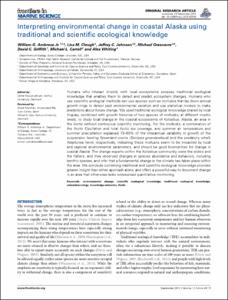Interpreting environmental change in coastal Alaska using traditional and scientific ecological knowledge.

View/
Average rating
votes
Date
2014Author
Ambrose, William G. Jr
Clough, Lisa M.
Johnson, Jeffrey C.
Greenacre, Michael
Griffith, David C.
Carroll, Michael L.
Whiting, Alex
Metadata
Show full item recordAbstract
Humans who interact directly with local ecosystems possess traditional ecological knowledge that enables them to detect and predict ecosystem changes. Humans who use scientific ecological methods can use species such as mollusks that lay down annual growth rings to detect past environmental variation and use statistical models to make predictions about future change. We used traditional ecological knowledge shared by local Inupiaq, combined with growth histories of two species of mollusks, at different trophic levels, to study local change in the coastal ecosystems of Kotzebue, Alaska, an area in the Arctic without continuous scientific monitoring. For the mollusks, a combination of the Arctic Oscillation and total Arctic ice coverage, and summer air temperature and summer precipitation explained 79-80% of the interannual variability in growth of the suspension feeding Greenland cockle (Serripes groenlandicus) and the predatory whelk (Neptunea hero), respectively, indicating these moll.....
Journal
Frontiers in Marine ScienceVolume
1Issue
Article 40Page Range
15pp.Document Language
enSustainable Development Goals (SDG)
14.aMaturity Level
Pilot or DemonstratedSpatial Coverage
Chukchi SeaDOI Original
https://doi.org/10.3389/fmars.2014.00040Citation
Ambrose, W. G., Clough, L. M., Johnson, J. C., Greenacre, M., Griffith, D. C., Carroll, M. L. and Whiting, A. (2014) Interpreting environmental change in coastal Alaska using traditional and scientific ecological knowledge. Frontiers in Marine Science, 1:40, 15pp. DOI: https://www.frontiersin.org/articles/10.3389/fmars.2014.00040Collections
- CAPARDUS Practices [244]
The following license files are associated with this item:
 Repository of community practices in Ocean Research, Applications and Data/Information Management
Repository of community practices in Ocean Research, Applications and Data/Information Management
